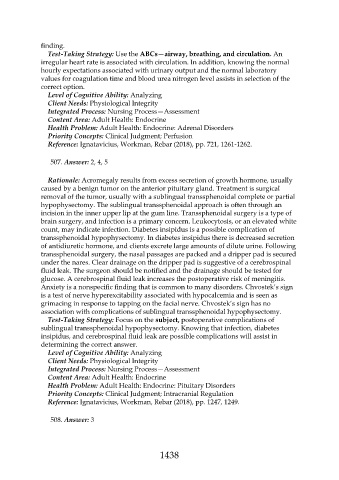Page 1438 - Saunders Comprehensive Review For NCLEX-RN
P. 1438
finding.
Test-Taking Strategy: Use the ABCs—airway, breathing, and circulation. An
irregular heart rate is associated with circulation. In addition, knowing the normal
hourly expectations associated with urinary output and the normal laboratory
values for coagulation time and blood urea nitrogen level assists in selection of the
correct option.
Level of Cognitive Ability: Analyzing
Client Needs: Physiological Integrity
Integrated Process: Nursing Process—Assessment
Content Area: Adult Health: Endocrine
Health Problem: Adult Health: Endocrine: Adrenal Disorders
Priority Concepts: Clinical Judgment; Perfusion
Reference: Ignatavicius, Workman, Rebar (2018), pp. 721, 1261-1262.
507. Answer: 2, 4, 5
Rationale: Acromegaly results from excess secretion of growth hormone, usually
caused by a benign tumor on the anterior pituitary gland. Treatment is surgical
removal of the tumor, usually with a sublingual transsphenoidal complete or partial
hypophysectomy. The sublingual transsphenoidal approach is often through an
incision in the inner upper lip at the gum line. Transsphenoidal surgery is a type of
brain surgery, and infection is a primary concern. Leukocytosis, or an elevated white
count, may indicate infection. Diabetes insipidus is a possible complication of
transsphenoidal hypophysectomy. In diabetes insipidus there is decreased secretion
of antidiuretic hormone, and clients excrete large amounts of dilute urine. Following
transsphenoidal surgery, the nasal passages are packed and a dripper pad is secured
under the nares. Clear drainage on the dripper pad is suggestive of a cerebrospinal
fluid leak. The surgeon should be notified and the drainage should be tested for
glucose. A cerebrospinal fluid leak increases the postoperative risk of meningitis.
Anxiety is a nonspecific finding that is common to many disorders. Chvostek’s sign
is a test of nerve hyperexcitability associated with hypocalcemia and is seen as
grimacing in response to tapping on the facial nerve. Chvostek’s sign has no
association with complications of sublingual transsphenoidal hypophysectomy.
Test-Taking Strategy: Focus on the subject, postoperative complications of
sublingual transsphenoidal hypophysectomy. Knowing that infection, diabetes
insipidus, and cerebrospinal fluid leak are possible complications will assist in
determining the correct answer.
Level of Cognitive Ability: Analyzing
Client Needs: Physiological Integrity
Integrated Process: Nursing Process—Assessment
Content Area: Adult Health: Endocrine
Health Problem: Adult Health: Endocrine: Pituitary Disorders
Priority Concepts: Clinical Judgment; Intracranial Regulation
Reference: Ignatavicius, Workman, Rebar (2018), pp. 1247, 1249.
508. Answer: 3
1438

